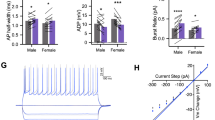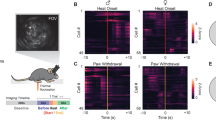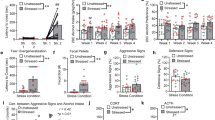Abstract
Corticotropin-releasing factor (CRF) has a key role in the central stress response, and altered levels of this neuropeptide are linked to stress-related psychopathologies such as anxiety and depression. These disorders are associated with the inability to properly regulate stress response, specifically following exposure to prolonged stressful stimuli. Therefore, the current study assessed the effects of prolonged and site-specific over-expression of CRF, which mimics the state of chronic production, in extended amygdala nuclei that are known to be involved in mediating anxiety-like states. We first constructed and generated lentiviruses that overexpress (OE) CRF in a robust and stable manner, and then generated two male mouse models continuously over-expressing CRF, either at the central nucleus of the amygdala (CeA), or at the dorsolateral subdivision of the bed nucleus of the stria terminalis (BNSTdl). After 4 months, behavioral assessments were conducted for anxiety and depressive indices on these mice. Surprisingly, prolonged CRF OE at the CeA attenuated stress-induced anxiety-like behaviors, whereas prolonged CRF OE in the BNSTdl increased depressive-like behaviors, without affecting anxiety levels. These results show possible differential roles for CRF expressed by distinct loci of the extended amygdala, in mediating stress-induced emotional behaviors.
This is a preview of subscription content, access via your institution
Access options
Subscribe to this journal
Receive 12 print issues and online access
$259.00 per year
only $21.58 per issue
Buy this article
- Purchase on Springer Link
- Instant access to full article PDF
Prices may be subject to local taxes which are calculated during checkout








Similar content being viewed by others
References
Vale W, Spiess J, Rivier C, Rivier J . Characterization of a 41-residue ovine hypothalamic peptide that stimulates secretion of corticotropin and beta-endorphin. Science 1981; 213: 1394–1397.
Rivier C, Vale W . Modulation of stress-induced ACTH release by corticotropin releasing factor, catecholamines and vasopressin. Nature 1983; 305: 325–327.
Muglia L, Jacobson L, Dikkes P, Majzoub JA . Corticotropin-releasing hormone deficiency reveals major fetal but not adult glucocorticoid need. Nature 1995; 373: 427–432.
Sutton RE, Koob GF, LeMoal M, Rivier J, Vale WW . Corticotropin-releasing factor (CRF) produces behavioral activation in rats. Nature 1982; 297: 331–333.
Brown MR, Fisher LA, Spiess J, Rivier C, Rivier J, Vale W . Corticotropin-releasing factor (CRF): actions on the sympathetic nervous system and metabolism. Endocrinology 1982; 111: 928–931.
Koob GF, Heinrichs SC . A role for corticotropin releasing factor and urocortin in behavioral responses to stressors. Brain Res 1999; 848: 141–152.
Joëls M, Baram TZ . The neuro-symphony of stress. Nat Rev Neurosci 2009; 10: 459–466.
Holsboer F . The rationale for corticotropin-releasing hormone receptor (CRH-R) antagonists to treat depression and anxiety. J Psychiatr Res 1999; 33: 181–214.
Arborelius L, Owens MJ, Plotsky PM, Nemeroff CB . The role of corticotropin-releasing factor in depression and anxiety disorders. J Endocrinol 1999; 160: 1–12.
Nemeroff CB . The role of corticotropin-releasing factor in the pathogenesis of major depression. Pharmacopsychiatry 1988; 21: 76–82.
Nemeroff CB . New vistas in neuropeptide research in neuropsychiatry: focus on corticotropin-releasing factor. Neuropsychopharmacology 1992; 6: 69–75.
Reul JM, Holsboer F . Corticotropin-releasing factor receptors 1 and 2 in anxiety and depression. Curr Opin Pharmacol 2002; 2: 23–33.
De Kloet ER, Joels M, Holsboer F . Stress and the brain: from adaptation to disease. Nat Rev Neurosci 2005; 6: 463–475.
McEwen BS . Glucocorticoids, depression, and mood disorders: structural remodeling in the brain. Metabolism 2005; 54: 20–23.
Lopez JF, Akil H, Watson SJ . Neural circuits mediating stress. Biol Psychiatry 1999; 46: 1461–1471.
Zorrilla EP, Koob GF . The therapeutic potential of CRF1 antagonists for anxiety. Expert Opin Investig Drugs 2004; 137: 799–828.
Heinrichs SC, Koob GF . Corticotropin-releasing factor in brain: a role in activation, arousal, and affect regulation. J Pharmacol Exp Ther 2004; 311: 427–440.
Holmes A, Heilig M, Rupniak NM, Steckler T, Griebel G . Neuropeptide systems as novel therapeutic targets for depression and anxiety disorders. Trends Pharmacol Sci 2003; 24: 580–588.
Bale TL . Sensitivity to stress: dysregulation of CRF pathways and disease development. Horm Behav 2005; 48: 1–10.
Chrousos GP, Gold PW . The concepts of stress and stress system disorders. Overview of physical and behavioral homeostasis. JAMA 1992; 267: 1244–1252.
Griebel G, Perrault G, Sanger DJ . Characterization of the behavioral profile of the non-peptide CRF receptor antagonist CP-154,526 in anxiety models in rodents. Comparison with diazepam and buspirone. Psychopharmacology 1998; 138: 55–66.
Griebel G, Simiand J, Steinberg R, Jung M, Gully D, Roger P et al. 4-(2-Chloro-4-methoxy-5-methylphenyl)-N-[(1S)-2-cyclopropyl-1-(3-fluoro-4-methylphenyl)ethyl]5-methyl-N-(2-propynyl)-1, 3-thiazol-2-amine hydrochloride (SSR125543A), a potent and selective corticotrophin-releasing factor(1) receptor antagonist. II. Characterization in rodent models of stress-related disorders. J Pharmacol Exp Ther 2002; 301: 333–345.
Arborelius L . Chronic administration of the selective corticotropin-releasing factor 1 receptor antagonist CP-154,526: behavioral, endocrine and neurochemical effects in the rat. J Pharmacol Exp Ther 2000; 294: 588–597.
Timpl P, Spanagel R, Sillaber I, Kresse A, Reul JM, Stalla GK et al. Impaired stress response and reduced anxiety in mice lacking a functional corticotropin-releasing hormone receptor 1. Nat Genet 1998; 19: 162–166.
Heinrichs SC, Lapsansky J, Lovenberg TW, De Souza EB, Chalmers DT . Corticotropin-releasing factor CRF1, but not CRF2, receptors mediate anxiogenic-like behavior. Regul Pept 1997; 71: 15–21.
Müller MB, Zimmermann S, Sillaber I, Hagemeyer TP, Deussing JM, Timpl P et al. Limbic corticotropin-releasing hormone receptor 1 mediates anxiety-related behavior and hormonal adaptation to stress. Nat Neurosci 2003; 6: 1100–1107.
Alheid GF . Extended amygdala and basal forebrain. Ann N Y Acad Sci 2003; 985: 185–205.
Lee Y, Davis M . Role of the hippocampus, the bed nucleus of the stria terminalis, and the amygdala in the excitatory effect of corticotropin-releasing hormone on the acoustic startle reflex. J Neurosci 1997; 17: 6434–6446.
Walker DL, Davis M . Double dissociation between the involvement of the bed nucleus of the stria terminalis and the central nucleus of the amygdala in startle increases produced by conditioned versus unconditioned fear. J Neurosci 1997; 17: 9375–9383.
Davis M . Are different parts of the extended amygdala involved in fear versus anxiety? Biol Psychiatry 1998; 44: 1239–1247.
Naldini L, Blömer U, Gage FH, Trono D, Verma IM . Efficient transfer, integration, and sustained long-term expression of the transgene in adult rat brains injected with a lentiviral vector. Proc Natl Acad Sci USA 1996; 93: 11382–11388.
Naldini L, Blömer U, Gallay P, Ory D, Mulligan R, Gage FH et al. In vivo gene delivery and stable transduction of non dividing cells by a lentiviral vector. Science 1996; 272: 263–267.
Korosi A, Veening JG, Kozicz T, Henckens M, Dederen J, Groenink L et al. Distribution and expression of CRF receptor 1 and 2 mRNAs in the CRF over-expressing mouse brain. Brain Res 2006; 1072: 46–54.
Bilkei-Gorzo A, Racz I, Michel K, Darvas M, Maldonado R, Zimmer A . A common genetic predisposition to stress sensitivity and stress-induced nicotine craving. Biol Psychiatry 2008; 63: 164–171.
Groenink L, Dirks A, Verdouw PM, de Graaff M, Peeters BW, Millan MJ et al. CRF1 not glucocorticoid receptors mediate prepulse inhibition deficits in mice overexpressing CRF. Biol Psychiatry 2008; 63: 360–368.
Chen A, Zorrilla E, Smith S, Rousso D, Levy C, Vaughan J . Urocortin 2-deficient mice exhibit gender-specific alterations in circadian hypothalamus-pituitary-adrenal axis and depressive-like behavior. J Neurosci 2006; 26: 5500–5510.
Viau V, Sawchenko PE . Hypophysiotropic neurons of the paraventricular nucleus respond in spatially, temporally, and phenotypically differentiated manners to acute vs repeated restraint stress. J Comp Neurol 2002; 445: 293–307.
Campeau S, Davis M . Involvement of the central nucleus and basolateral complex of the amygdala in fear conditioning measured with fear-potentiated startle in rats trained concurrently with auditory and visual conditioned stimuli. J Neurosci 1995; 15: 2301–2311.
Campeau S, Davis M . Involvement of subcortical and cortical afferents to the lateral nucleus of the amygdala in fear conditioning measured with fear-potentiated startle in rats trained concurrently with auditory and visual conditioned stimuli. J Neurosci 1995; 15: 2312–2327.
Hitchcock J, Davis M . Lesions of the amygdala, but not of the cerebellum or bed nucleus, block conditioned fear as measured with the potentiated startle paradigm. Behav Neurosci 1986; 100: 11–22.
Hitchcock JM, Davis M . Fear-potentiated startle using an auditory conditioned stimulus: effect of lesions of the amygdala. Physiol Behav 1987; 39: 403–408.
Kim M, Campeau S, Falls WA, Davis M . Infusion of the non-NMDA receptor antagonist CNQX into the amygdala blocks the expression of fear-potentiated startle. Behav Neural Biol 1993; 59: 5–8.
Albeck DS, McKittrick CR, Blanchard DC, Blanchard RJ, Nikulina J, McEwen BS et al. Chronic social stress alters levels of corticotropin-releasing factor and arginine vasopressin mRNA in rat brain. J Neurosci 1997; 17: 4895–4903.
Stout SC, Mortas P, Owens MJ, Nemeroff CB, Moreau J . Increased corticotropin-releasing factor concentrations in the bed nucleus of the stria terminalis of anhedonic rats. Eur J Pharmacol 2000; 401: 39–46.
Nestler EJ, Barrot M, DiLeone RJ, Eisch AJ, Gold SJ, Monteggia LM . Neurobiology of depression. Neuron 2002; 34: 13–25.
Stenzel-Poore MP, Cameron VA, Vaughan J, Sawchenko PE, Vale W . Development of Cushing's syndrome in corticotropin-releasing factor transgenic mice. Endocrinology 1992; 130: 3378–3386.
Stenzel-Poore MP, Heinrichs SC, Rivest S, Koob GF, Vale WW . Overproduction of corticotropin-releasing factor in transgenic mice: a genetic model of anxiogenic behavior. J Neurosci 1994; 14: 2579–2584.
Groenink L, Dirks A, Verdouw PM, Schipholt M, Veening JG, van der Gugten J et al. HPA axis dysregulation in mice overexpressing corticotropin releasing hormone. Biol Psychiatry 2002; 51: 875–881.
Dirks A, Groenink L, Bouwknecht JA, Hijzen TH, Van Der Gugten J, Ronken E et al. Overexpression of corticotropin-releasing hormone in transgenic mice and chronic stress-like autonomic and physiological alterations. Eur J Neurosci 2002; 16: 1751–1760.
Lu A, Steiner MA, Whittle N, Vogl AM, Walser SM, Ableitner M et al. Conditional mouse mutants highlight mechanisms of corticotropin-releasing hormone effects on stress-coping behavior. Mol Psychiatry 2008; 13: 1028–1042.
Sajdyk TJ, Schober DA, Gehlert DR, Shekhar A . Role of corticotropin-releasing factor and urocortin within the basolateral amygdala of rats in anxiety and panic responses. Behav Brain Res 1999; 100: 207–215.
Iredale PA, Terwilliger R, Widnell KL, Nestler EJ, Duman RS . Differential regulation of corticotropin-releasing factor1 receptor expression by stress and agonist treatments in brain and cultured cells. Mol Pharmacol 1996; 50: 1103–1110.
Brunson KL, Grigoriadis DE, Lorang MT, Baram TZ . Corticotropin-releasing hormone (CRH) downregulates the function of its receptor (CRF1) and induces CRF1 expression in hippocampal and cortical regions of the immature rat brain. Exp Neurol 2002; 176: 75–86.
Rasmussen TN, Novak I, Nielsen SM . Internalization of the human CRF receptor 1 is independent of classical phosphorylation sites and of beta-arrestin 1 recruitment. Eur J Biochem 2004; 271: 4366–4374.
Oakley RH, Olivares-Reyes JA, Hudson CC, Flores-Vega F, Dautzenberg FM, Hauger RL . Carboxyl-terminal and intracellular loop sites for CRF1 receptor phosphorylation and beta-arrestin-2 recruitment: a mechanism regulating stress and anxiety responses. Am J Physiol Regul Integr Comp Physiol 2007; 293: R209–R222.
Perry SJ, Junger S, Kohout TA, Hoare SR, Struthers RS, Grigoriadis DE et al. Distinct conformations of the corticotropin releasing factor type 1 receptor adopted following agonist and antagonist binding are differentially regulated. J Biol Chem 2005; 280: 11560–11568.
Herringa RJ, Nanda SA, Hsu DT, Roseboom PH, Kalin NH . The effects of acute stress on the regulation of central and basolateral amygdala CRF-binding protein gene expression. Brain Res 2004; 131: 17–25.
Herringa RJ, Mackenrodt DB, Barlow JD, Roseboom PH, Nanda SA, Kalin NH . Corticotropin-releasing factor (CRF), but not corticosterone, increases basolateral amygdala CRF-binding protein. Brain Res 2006; 1083: 21–28.
Keen-Rhinehart E, Michopoulos V, Toufexis DJ, Martin EI, Nair H, Ressler KJ et al. Continuous expression of corticotropin-releasing factor in the central nucleus of the amygdala emulates the dysregulation of the stress and reproductive axes. Mol Psychiatry 2009; 14: 37–50.
Swanson LW, Sawchenko PE, Rivier J, Vale WW . Organization of ovine corticotropin-releasing factor immunoreactive cells and fibers in the rat brain: an immunohistochemical study. Neuroendocrinology 1983; 36: 165–186.
Dong HW, Petrovich GD, Swanson LW . Topography of projections from amygdala to bed nuclei of the stria terminalis. Brain Res Brain Res Rev 2001; 38: 192–246.
Sakanaka M, Shibasaki T, Lederis K . Distribution and efferent projections of corticotropin-releasing factor-like immunoreactivity in the rat amygdaloid complex. Brain Res 1986; 382: 213–238.
Roozendaal B, Brunson KL, Holloway BL, McGaugh JL, Baram TZ . Involvement of stress-released corticotropin-releasing hormone in the basolateral amygdala in regulating memory consolidation. Proc Natl Acad Sci USA 2002; 99: 13908–13913.
Bale TL . Stress sensitivity and the development of affective disorders. Horm Behav 2006; 50: 529–533.
Krishnan V, Nestler EJ . The molecular neurobiology of depression. Nature 2008; 455: 894–902.
Kim SJ, Park SH, Choi SH, Moon BH, Lee KJ, Kang SW et al. Effects of repeated tianeptine treatment on CRF mRNA expression in non-stressed and chronic mild stress-exposed rats. Neuropharmacology 2006; 50: 824–833.
Herman JP, Cullinan WE, Watson SJ . Involvement of the bed nucleus of the stria terminalis in tonic regulation of paraventricular hypothalamic CRH and AVP mRNA expression. J Neuroendocrinol 1994; 6: 433–442.
Acknowledgements
AC is incumbent of the Philip Harris and Gerald Ronson Career Development Chair. This work is supported by: A Research Grant from the Israel Science Foundation; A Research Grant from Roberto and Renata Ruhman; A Research Grant from the Legacy Heritage Biomedical Science Partnership; A Research Grant from The National Institute for Psychobiology in Israel—Founded by the Charles E Smith Family; A Research Grant from the Israel Ministry of Health; A Grant from Mr and Mrs Mike Kahn; A Research Grant from Mr Jorge David Ashkenazi, A Research Grant from Mr and Mrs Barry Wolfe; A Research Grant from Nella and Leon Benoziyo Center for Neurosciences and Neurological Diseases.
Author information
Authors and Affiliations
Corresponding author
Ethics declarations
Competing interests
The authors declare no conflict of interest
Additional information
Supplementary Information accompanies the paper on the Molecular Psychiatry website
Rights and permissions
About this article
Cite this article
Regev, L., Neufeld-Cohen, A., Tsoory, M. et al. Prolonged and site-specific over-expression of corticotropin-releasing factor reveals differential roles for extended amygdala nuclei in emotional regulation. Mol Psychiatry 16, 714–728 (2011). https://doi.org/10.1038/mp.2010.64
Received:
Revised:
Accepted:
Published:
Issue Date:
DOI: https://doi.org/10.1038/mp.2010.64
Keywords
This article is cited by
-
Oxytocin facilitates adaptive fear and attenuates anxiety responses in animal models and human studies—potential interaction with the corticotropin-releasing factor (CRF) system in the bed nucleus of the stria terminalis (BNST)
Cell and Tissue Research (2019)
-
Inferior olive CRF plays a role in motor performance under challenging conditions
Translational Psychiatry (2018)
-
Melatonin Augments the Effects of Fluoxetine on Depression-Like Behavior and Hippocampal BDNF–TrkB Signaling
Neuroscience Bulletin (2018)
-
CRF-like receptor SEB-3 in sex-common interneurons potentiates stress handling and reproductive drive in C. elegans
Nature Communications (2016)
-
Region-specific roles of the corticotropin-releasing factor–urocortin system in stress
Nature Reviews Neuroscience (2016)



